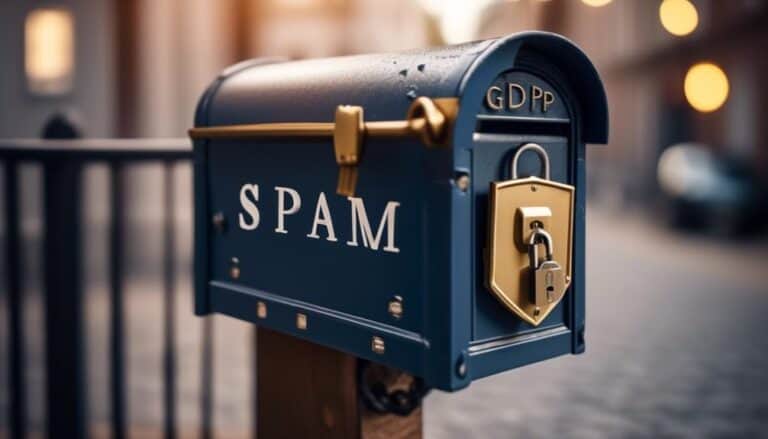Revolutionize Your Email Strategy With Advanced Authentication Techniques
Are you tired of constantly worrying about the security of your email communications? Looking for a way to revolutionize your email strategy and protect your valuable information? Look no further.
Advanced authentication techniques offer the solution you've been searching for. By implementing these techniques, you can ensure the integrity of your emails and prevent unauthorized access. But how exactly do they work?
In this discussion, we will explore the importance of email authentication and delve into the details of DMARC, SPF, and DKIM. Get ready to take your email security to the next level and say goodbye to your worries.
Key Takeaways
- Email authentication, including protocols like SPF, DKIM, and DMARC, is crucial for securing your email strategy and protecting your brand reputation.
- Implementing DMARC for enhanced email security allows you to specify policies for handling unauthenticated emails and prevents unauthorized use and email fraud.
- Leveraging SPF to prevent email spoofing verifies that incoming emails originate from authorized senders, reducing the risk of spoofing attacks.
- Ensuring email integrity with DKIM adds a digital signature to outgoing emails, establishing trust and credibility, and improving email deliverability rates.
The Importance of Email Authentication

Email authentication is a crucial step in securing your email strategy. Implementing email authentication best practices can provide numerous benefits for your business. One of the main benefits is the ability to verify the authenticity of your emails, ensuring that they aren't forged or tampered with. By using authentication protocols such as SPF (Sender Policy Framework), DKIM (DomainKeys Identified Mail), and DMARC (Domain-based Message Authentication, Reporting, and Conformance), you can prevent unauthorized use of your domain and protect your brand reputation.
Email authentication also helps in reducing spam and phishing attacks. By implementing these techniques, you can increase the deliverability of your emails, as they're less likely to be flagged as spam by email filters. This can lead to higher open rates and engagement with your customers.
Additionally, email authentication allows you to establish a secure communication channel with your recipients, ensuring that sensitive information remains confidential and protected.
Understanding DMARC, SPF, and DKIM
Understanding DMARC, SPF, and DKIM is essential for implementing effective email authentication techniques. These three protocols work together to protect your email domain from spoofing, phishing, and other malicious activities.
Common misconceptions about email authentication include the belief that SPF, DKIM, or DMARC alone can provide complete protection. In reality, a comprehensive email authentication strategy requires the implementation of all three protocols. SPF (Sender Policy Framework) verifies the sender's IP address, DKIM (DomainKeys Identified Mail) verifies the integrity of the email content, and DMARC (Domain-based Message Authentication, Reporting, and Conformance) provides a policy framework for email authentication.
To implement these protocols effectively, it's important to follow best practices. Start by publishing an SPF record that lists the authorized IP addresses for your domain. This helps receiving mail servers verify the authenticity of your emails.
Next, generate a DKIM signature for your outgoing emails to ensure their integrity.
Implementing DMARC for Enhanced Email Security

To enhance email security, consider implementing DMARC for comprehensive protection against spoofing and phishing attempts. DMARC, which stands for Domain-based Message Authentication, Reporting, and Conformance, is an email authentication protocol that helps organizations protect their domains from unauthorized use and prevent email fraud. By implementing DMARC, you can ensure that only legitimate emails from authorized senders are delivered to recipients.
To understand the benefits of implementing DMARC, let's take a look at the following table:
| Benefits of Implementing DMARC | Description |
|---|---|
| Domain Protection | DMARC allows you to specify policies for how email servers should handle unauthenticated emails from your domain. This prevents attackers from spoofing your domain and helps protect your brand reputation. |
| Email Authentication Best Practices | DMARC builds upon the existing email authentication protocols of SPF (Sender Policy Framework) and DKIM (DomainKeys Identified Mail). By implementing DMARC, you can ensure that these authentication mechanisms are properly configured and provide an additional layer of security. |
Implementing DMARC requires configuring your DNS records to publish DMARC policies, monitoring email authentication results, and gradually enforcing the policies to protect your domain. It is important to follow best practices and guidelines provided by DMARC.org to ensure successful implementation and maximize the effectiveness of DMARC in enhancing your email security.
Leveraging SPF to Prevent Email Spoofing
Consider leveraging SPF, an email authentication protocol, to prevent email spoofing and enhance the security of your email communications. Email spoofing is a common technique used by attackers to send fraudulent emails that appear to come from a legitimate source. SPF, which stands for Sender Policy Framework, helps prevent email spoofing by allowing email receivers to verify that the incoming emails actually originate from an authorized sender.
SPF works by publishing a list of authorized mail servers in the DNS records of the sender's domain. When an email is received, the receiving mail server can check the SPF record of the sender's domain to verify if the email is being sent from an authorized server. If the email isn't sent from an authorized server, it can be flagged as suspicious or rejected altogether.
Implementing SPF can enhance the security of your email communications by reducing the risk of email spoofing attacks. However, there are some challenges to consider when implementing SPF. One challenge is accurately identifying and listing all authorized mail servers in the SPF record. This can be a complex task, especially for organizations with multiple mail servers or third-party email providers.
To overcome this challenge, it's essential to carefully analyze your email infrastructure and identify all authorized mail servers. Regularly reviewing and updating the SPF record can help ensure that it remains accurate and effective in preventing email spoofing.
Ensuring Email Integrity With DKIM

Ensure the integrity of your emails with the use of DKIM, a widely adopted email authentication method. DKIM, which stands for DomainKeys Identified Mail, adds a digital signature to your outgoing emails, allowing recipients to verify that the message wasn't tampered with during transit. By implementing DKIM, you can enhance email deliverability and protect your brand reputation.
Here are some key benefits of email authentication with DKIM:
- Message Integrity: DKIM ensures that the content of your emails remains unchanged during transit, providing recipients with confidence in the authenticity and integrity of the message.
- Reduced Spam Filtering: Email providers and spam filters are more likely to deliver authenticated emails to recipients' inboxes, as DKIM helps establish trust and credibility.
- Brand Protection: DKIM helps protect your brand by preventing unauthorized individuals from sending spoofed emails that appear to be from your domain.
- Improved Email Deliverability: By using DKIM, you can increase your chances of avoiding spam folders and reaching your intended recipients, ultimately improving your email deliverability rates.
Implementing DKIM is a crucial step in securing your email communications and ensuring that your messages are delivered reliably and securely. By adopting this email authentication method, you can protect your brand, enhance email deliverability, and establish trust with your recipients.
Frequently Asked Questions
How Can I Ensure That My Emails Are Not Being Spoofed or Used for Phishing Attacks?
To ensure your emails are not spoofed or used for phishing attacks, learn how to detect and report phishing emails. Implement email authentication techniques, such as SPF, DKIM, and DMARC, to prevent email spoofing and protect your recipients.
Are There Any Potential Drawbacks or Challenges in Implementing Dmarc?
You may face potential drawbacks and challenges in implementing DMARC. These include a lack of awareness and understanding among email service providers and organizations, as well as difficulty coordinating with multiple domains and third party vendors for alignment and authentication.
What Are Some Best Practices for Configuring SPF Records to Prevent Email Spoofing?
To prevent email spoofing and configure SPF records effectively, ensure you set up a strict SPF policy, include all authorized sending sources, and use the "all" mechanism to reject unauthorized senders.
Can I Use DMARC, SPF, and DKIM Together to Further Enhance Email Security?
Yes, you can use DMARC, SPF, and DKIM together to enhance email security. Implementing DMARC provides additional authentication and verification measures, reducing the risk of email spoofing and increasing the overall security of your email strategy.
Are There Any Specific Industries or Sectors That Are More Vulnerable to Email Spoofing and Phishing Attacks?
Industries vulnerable to email spoofing and phishing attacks include finance and healthcare. These sectors handle sensitive information, making them attractive targets for cybercriminals. Implementing advanced authentication techniques can help mitigate these risks.
Conclusion
Revamp your email strategy by adopting advanced authentication techniques such as DMARC, SPF, and DKIM. These methods play a crucial role in enhancing email security, preventing spoofing, and ensuring the integrity of your emails.
By implementing DMARC, you can detect and mitigate email fraud, while SPF helps in authenticating the sender's identity. Additionally, DKIM adds an extra layer of protection by verifying the email's integrity.
Strengthen your email defenses and protect your organization from cyber threats with these powerful authentication techniques.








